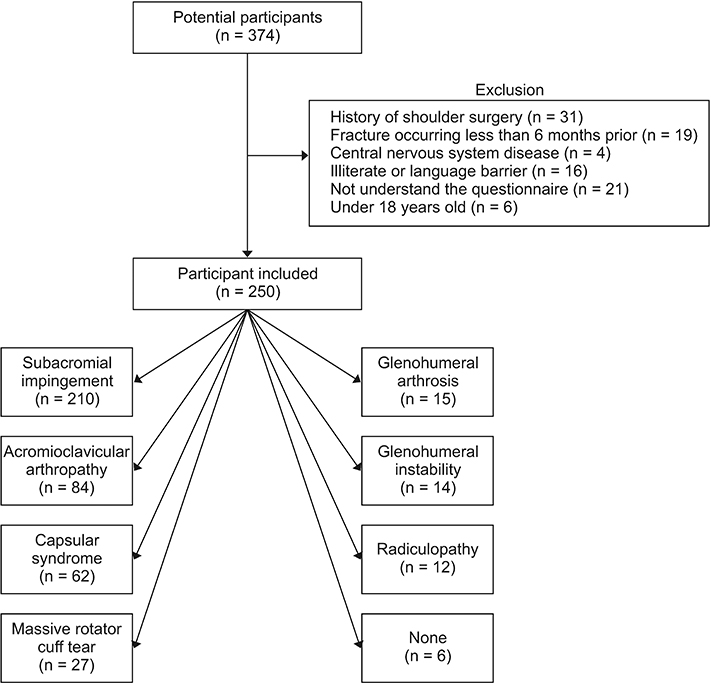Healthc Inform Res.
2019 Apr;25(2):82-88. 10.4258/hir.2019.25.2.82.
Design and Validation of a Computer Application for Diagnosis of Shoulder Locomotor System Pathology
- Affiliations
-
- 1Department of Rehabilitation, Santa Maria University Hospital, Lleida, Spain. albertbs@gmail.com
- 2University of Lleida, Lleida, Spain.
- 3The Lleida Biomedical Research Institute's Dr. Pifarré Foundation (IRBLleida), Lleida, Spain.
- 4Intensive Care Unit and Department of Rehabilitation, Arnau de Vilanova University Hospital, Lleida, Spain.
- 5Department of Rehabilitation, Onze de Setembre Primary Care Center, Lleida, Spain.
- KMID: 2445004
- DOI: http://doi.org/10.4258/hir.2019.25.2.82
Abstract
OBJECTIVES
To design and validate a computer application for the diagnosis of shoulder locomotor system pathology.
METHODS
The first phase involved the construction of the application using the Delphi method. In the second phase, the application was validated with a sample of 250 patients with shoulder pathology. Validity was measured for each diagnostic group using sensitivity, specificity, and positive and negative likelihood ratio (LR(+) and LR(−)). The correct classification ratio (CCR) for each patient and the factors related to worse classification were calculated using multivariate binary logistic regression (odds ratio, 95% confidence interval).
RESULTS
The mean time to complete the application was 15 ± 7 minutes. The validity values were the following: LR(+) 7.8 and LR(−) 0.1 for cervical radiculopathy, LR(+) 4.1 and LR(−) 0.4 for glenohumeral arthrosis, LR(+) 15.5 and LR(−) 0.2 for glenohumeral instability, LR(+) 17.2 and LR(−) 0.2 for massive rotator cuff tear, LR(+) 6.2 and LR(−) 0.2 for capsular syndrome, LR(+) 4.0 and LR(−) 0.3 for subacromial impingement/rotator cuff tendinopathy, and LR(+) 2.5 and LR(−) 0.6 for acromioclavicular arthropathy. A total of 70% of the patients had a CCR greater than 85%. Factors that negatively affected accuracy were massive rotator cuff tear, acromioclavicular arthropathy, age over 55 years, and high pain intensity (p < 0.05).
CONCLUSIONS
The developed application achieved an acceptable validity for most pathologies. Because the tool had a limited capacity to identify the full clinical picture in the same patient, improvements and new studies applied to other groups of patients are required.
Keyword
MeSH Terms
Figure
Reference
-
1. Urwin M, Symmons D, Allison T, Brammah T, Busby H, Roxby M, et al. Estimating the burden of musculoskeletal disorders in the community: the comparative prevalence of symptoms at different anatomical sites, and the relation to social deprivation. Ann Rheum Dis. 1998; 57(11):649–655.
Article2. Linsell L, Dawson J, Zondervan K, Rose P, Randall T, Fitzpatrick R, Carr A. Prevalence and incidence of adults consulting for shoulder conditions in UK primary care; patterns of diagnosis and referral. Rheumatology (Oxford). 2006; 45(2):215–221.
Article3. Kennedy CA, Manno M, Hogg-Johnson S, Haines T, Hurley L, McKenzie D, et al. Prognosis in soft tissue disorders of the shoulder: predicting both change in disability and level of disability after treatment. Phys Ther. 2006; 86(7):1013–1037.
Article4. Kooijman MK, Barten DJ, Swinkels IC, Kuijpers T, de Bakker D, Koes BW, et al. Pain intensity, neck pain and longer duration of complaints predict poorer outcome in patients with shoulder pain: a systematic review. BMC Musculoskelet Disord. 2015; 16:288.
Article5. Kooijman M, Swinkels I, van Dijk C, de Bakker D, Veenhof C. Patients with shoulder syndromes in general and physiotherapy practice: an observational study. BMC Musculoskelet Disord. 2013; 14:128.
Article6. Lee JH. Future of the smartphone for patients and healthcare providers. Healthc Inform Res. 2016; 22(1):1–2.
Article7. Research2Guidance. mHealth app developer economics 2016 [Internet]. Berlin, Germany: Research2Guidance;c2019. cited at 2018 Apr 15. Available from: https://research2guidance.com/product/mhealth-app-developereconomics-2016/.8. Silva BM, Rodrigues JJ, de la Torre Diez I, Lopez-Coronado M, Saleem K. Mobile-health: a review of current state in 2015. J Biomed Inform. 2015; 56:265–272.
Article9. Fox S, Duggan M. Health online 2013 [Internet]. Washington (DC): Pew Research Center;2013. cited at 2019 Apr 15. Available from: http://www.pewinternet.org/2013/01/15/health-online-2013/.10. Han M, Lee E. Effectiveness of mobile health application use to improve health behavior changes: a systematic review of randomized controlled trials. Healthc Inform Res. 2018; 24(3):207–226.
Article11. Ostor AJ, Richards CA, Prevost AT, Speed CA, Hazleman BL. Diagnosis and relation to general health of shoulder disorders presenting to primary care. Rheumatology (Oxford). 2005; 44(6):800–805.
Article12. Gartner J, Blauth W, Hahne HJ. The value of the anamnesis for the probability diagnosis of shoulder pain. Z Orthop Ihre Grenzgeb. 1991; 129(4):322–325.13. Farmer N, Schilstra MJ. A knowledge-based diagnostic clinical decision support system for musculoskeletal disorders of the shoulder for use in a primary care setting. Shoulder Elbow. 2012; 4(2):141–151.
Article14. Farmer N. An update and further testing of a knowledge-based diagnostic clinical decision support system for musculoskeletal disorders of the shoulder for use in a primary care setting. J Eval Clin Pract. 2014; 20(5):589–595.
Article15. Honekamp W, Hanseroth S. Evaluation of an online information system for shoulder pain patients. Int J Comput Inf Technol. 2013; 2(3):442–446.16. Bond WF, Schwartz LM, Weaver KR, Levick D, Giuliano M, Graber ML. Differential diagnosis generators: an evaluation of currently available computer programs. J Gen Intern Med. 2012; 27(2):213–219.
Article17. Lee YS. Value-based health technology assessment and health informatics. Healthc Inform Res. 2017; 23(3):139–140.
Article
- Full Text Links
- Actions
-
Cited
- CITED
-
- Close
- Share
- Similar articles
-
- Application of Virtual Surgical Planning with Computer Assisted Design and Manufacturing Technology to Cranio-Maxillofacial Surgery
- Fabrication of computer-aided design/computer-aided manufacturing complete denture and conventional complete denture: case report
- Computerization of 100,000 cases of Surgical Pathology Data at SNUH by Automatic Coding System using Personal Computer
- Development and Application of a Web-based Expert System using Artificial Intelligence for Management of Mental Health by Korean Emigrants
- Development and Evaluation of the Computerized Nursing Diagnosis/Intervention System for Nutritional and Eliminative Problem


